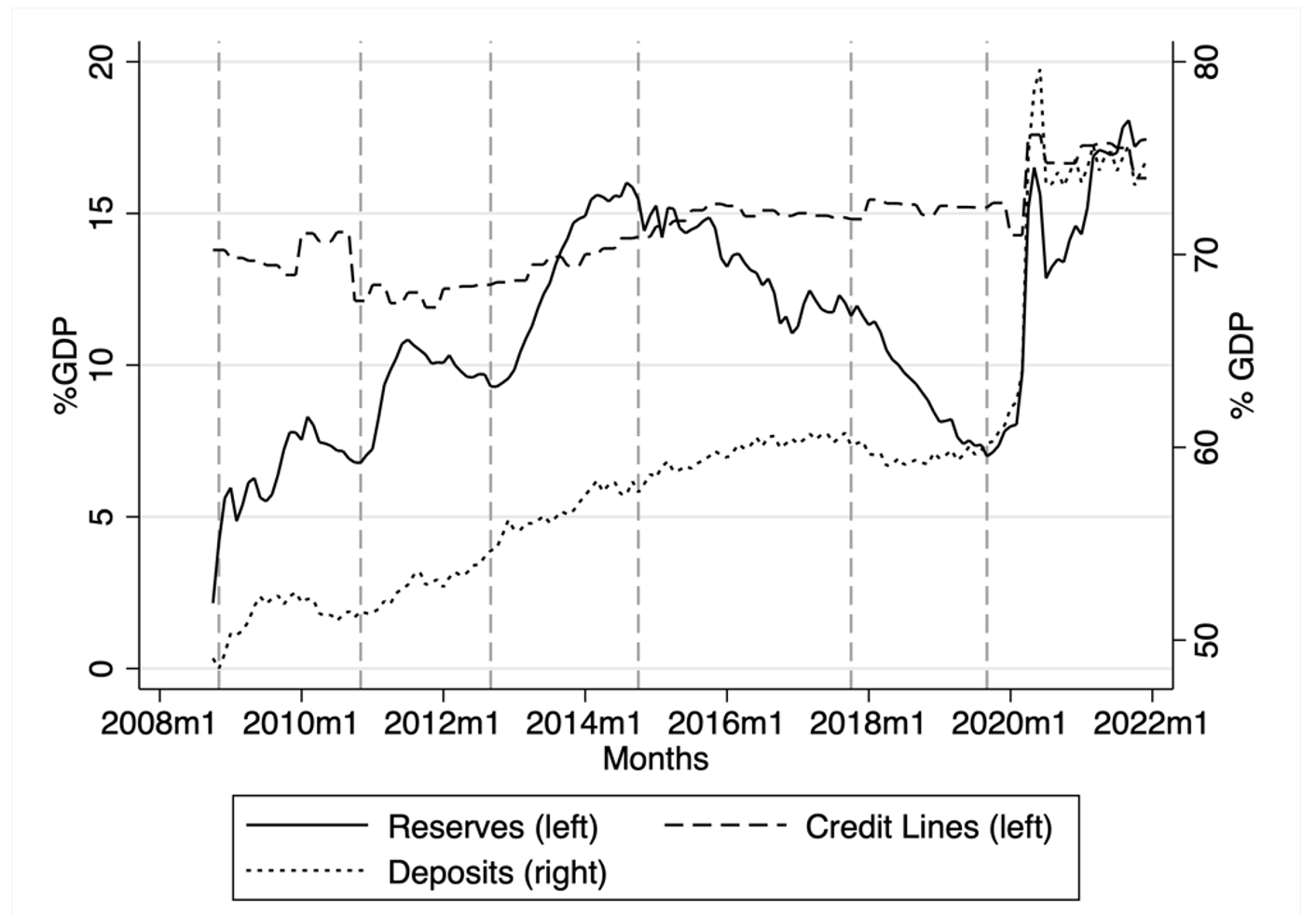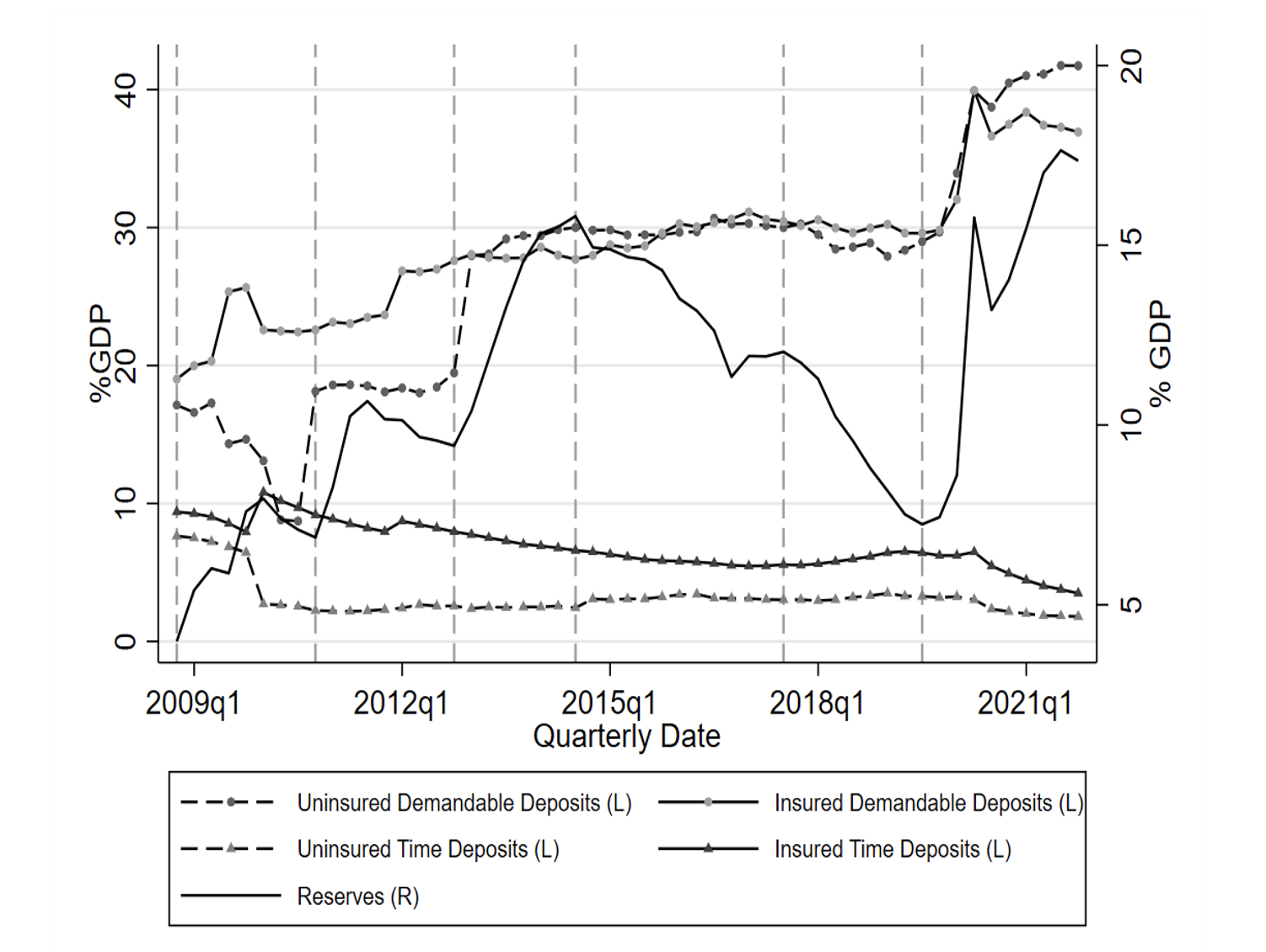Shouldn’t the reduction of the size of central bank balance sheets be an entirely benign process – like watching paint dry, as senior Fed officials put it? The central bank will either let bonds held as assets on its balance sheet mature or sell them, thus extinguishing reserves – its liabilities. While bond prices may have to adjust to draw in sufficient private replacement demand, and the swap of bonds for reserves with the private sector may enhance the term premium, these possible price adjustments seem natural consequences to the rebalancing of portfolios. Yet, when the Federal Reserve embarked the last time around on ‘quantitative tightening’, that is, a shrinkage of reserves, financial markets in the US experienced two episodes of significant liquidity stress – in September 2019 and again in March 2020 (by which time the Fed had already restarted injecting reserves). The former episode was attributed in part to significant reserve flows into the Treasury’s Fed account, leaving the private sector short, and in part to the uneven distribution of reserves across banks (e.g. Copeland et al. 2021, D’Avernas and Vandeweyer 2021). The latter episode is attributed to the panic surrounding the COVID-19 outbreak. Notwithstanding the relevance of these proximate causes, we ask whether the prior expansion and then shrinkage of the Fed’s balance sheet had left the private financial sector more vulnerable to such disruptions.
Acharya and Rajan (2022) argue that when the central bank expands its balance sheet, commercial banks, which (typically) have to hold the reserves the central bank issues to finance its asset purchases, tend to finance them with demandable deposits.
In part, the desire of banks to match the maturity of assets and liabilities moves them to issue such claims. In part, their enhanced holding of reserves gives banks the confidence they can service any enhanced deposit withdrawals. This is especially the case when reserves are in large supply, for example, during quantitative easing. The reserve holdings become a backstop for commercial banks to issue other fee-generating claims on liquidity, such as lines of credit and other off-balance-sheet commitments to provide financing, that is typically not called upon at the same time as deposits (Kashyap et al. 2002). However, in periods of stress when many claims on liquidity are drawn upon, there is far less ‘spare’ liquidity in the system than might be suggested by the increase in bank holdings of reserves.
What does the evidence say? In Acharya et al. (2022), we analyse data for the period 2008 to 2021, and document (see Figure 1A) that during the initial period of Fed balance sheet expansion – quantitative easing (QE) I from November 2008 to June 2010, QE II from November 2010 to June 2011, and QE III from September 2012 to October 2014 – as well as during the pandemic QE from March 2020, deposits issued and credit lines written by the commercial banks increased. In particular, demand deposits increased while time deposits decreased (see Figure 1B). Importantly, both figures show that bank-written claims on liquidity did not fall significantly when QE ended or when the process of actively shrinking the Fed’s balance sheet during quantitative tightening (QT) started in October 2017; instead, the ratio of demandable claims to reserves increased steeply over these periods. Equally importantly, there was also an expansion of uninsured demand deposits of banks (see Figure 1C), which typically were not held by households. This suggests that bank deposits were not rising simply due to a rise in household assets during QE, implying instead an active role played by banks.
Figure 1 Time series of aggregate credit lines, deposits and reserves
A) Credit lines, deposits, and reserves as a percentage of GDP
B) Demand (and other liquid) deposits, time deposits, and reserves as percentage of GDP
C) Uninsured and insured demand and time deposits, and reserves, as a percentage of GDP
Notes: This figure plots the time series of credit lines, deposits and reserves of the 2008 to 2021 period using data from the Federal Reserves’ Flow of Funds. Panel A plots credit lines (left y-axis), deposits (right y-axis) and reserves (left y-axis) as a percentage of gross domestic product (GDP) for all commercial banks. Panel B plots demand and other liquid deposits (right y-axis), time deposits (left y-axis) and reserves (left y-axis), all as a percentage of GDP. Time deposits are the sum of small and large time deposits (H6 and H8 releases). Demand and other liquid deposits are from the H6 release. Panel C shows the break-up of demand and time deposits into insured and uninsured time series using FDIC’s Call Reports Data. Estimation of insured and uninsured domestic deposits are based on the items in the call report schedule RC-O Insured deposits are defined as deposits lying below the FDIC deposit insurance thresholds of $100,000 before 2008 Q4 and $250,000 after 2008 Q4. Uninsured deposits are domestic deposits above the aforementioned deposit insurance thresholds and all foreign deposits Insured deposits are adjusted for the FDIC Transaction Account Guarantee (TAG) program. Split of time deposits into insured vs uninsured deposits is based by splits of time deposits by the aforementioned deposit insurance thresholds in schedule RC-E. Non-time insured and uninsured deposits are estimated by taking the difference between total insured/uninsured deposits and insured/uninsured time deposits, respectively. Non-time deposits are labelled as Demandable Deposits. The vertical lines correspond to the beginning of the different Federal Reserve QE / QT phases: (1) Nov 2008 (QE I), (2) Nov 2010 (QE II), (3) Nov 2012 (QE III), (4) Oct 2014 (Post-QE III), (5) QT period, (6) Sept 2019 (Pandemic QE).
We refer to this phenomenon – whereby the banking system acquires more on- and off-balance-sheet demandable claims during QE that are not simply reversed with QT – as ‘liquidity dependence’, since it necessitates even greater central bank balance sheet support in the future.
Liquidity claims also affect the aggregate pricing of liquidity. We build on the work of Lopez-Salido and Vissing-Jorgensen (2022) by showing that the effective Fed Funds rate less the interest on excess reserves, a measure of the price of liquidity, is influenced not just by aggregate reserves and aggregate commercial bank demandable deposits, but also aggregate lines of credit. This reinforces the point that aggregate claims on liquidity need to be accounted for before we can judge how much spare liquidity the system has.
To establish a causal link from bank behaviour to these phenomena, we turn to the cross-section of banks over time to obtain firmer evidence on the causal impact of reserves on the banking sector’s demandable claims. Using instrumental variable analysis, we find that during the periods of QE, banks that exogenously obtain more reserves tend to increase both demand deposits and issue credit lines, while simultaneously shrinking time deposits. Importantly, they do not reliably shrink deposits or credit lines when they lose reserves as QE ends and QT begins.
What about bank-level pricing of liquidity? Banks that have a greater concern about liquidity risk would tend to nudge term deposit rate spreads higher so that they can reduce their dependence on demand deposits. Therefore, a proxy for the price of liquidity at the bank level is how much higher the spread between term deposit interest rates and savings deposit interest rates are at the bank. We find that during periods of QE, banks with greater (exogenous or instrumented) reserves tend to reduce the term spread, consistent with their being less concerned about liquidity.
Interestingly again, we find that these patterns do not reliably persist in the period between when the first sequence of QE ends in October 2014 and when the central bank resumes expanding its balance sheet in September 2019. Put differently, banks that lose reserves do not raise term spread to raise the maturity of their deposits.
What might account for this behaviour? One possibility is that banks feel confident in their access to liquidity during QT because they substitute lost reserves with bonds that are eligible collateral for repo transactions. Of course, to the extent that repos must be conducted with other banks (because there is a stigma associated with borrowing from the Fed facilities), banks will all be reliant on a diminishing pool of ultimate liquidity, that is, reserves. So, in a situation where many banks want to transform eligible assets into reserves (a ‘dash for cash’), there will be too little to satisfy all. As Acharya and Rajan (2022) explain, this makes the banking system extremely dependent on ‘surplus reserves’ banks, and if these banks hoard liquidity in times of need, the banking system becomes fragile.
It turns out that the ratio of demandable claims (demand deposits and outstanding credit lines) to ‘liquid’ assets (reserves plus assets eligible for repo with the Fed) also increases during QT. Furthermore, the distribution of this ratio steadily shifts to the right, ie, the ratio moves to higher levels, through the different episodes of QE, continuing its momentum post-QE and during QT, and ends up with a significantly fatter right tail. For instance, the ratio for the bank holding company (BHC) at the 90th percentile in early 2010 was 12, but it had more than doubled to over 30 for the 90th percentile BHC in September 2019. This suggests that not only were aggregate liquidity claims rising relative to reserves and eligible assets as the Fed implemented QT, but the dispersion among banks was also increasing. Interestingly, smaller banks with weaker capital positions were more likely to take on liquidity risk, despite the low returns we also document from such risk-taking. It does seem there is an element of ‘picking up pennies in front of a steamroller’ in bank behaviour at such times.
In sum, the accumulation of reserves in the Treasury account and the uneven distribution of remaining reserves across banks were possibly the proximate causes of the Treasury repo rate spike in September 2019 – though Fed studies earlier in that year suggested the banking system had ample reserves, even accounting for unexpected variations such as in the Treasury’s Fed account (see Logan 2019). Our evidence suggests that the shrinkage of aggregate reserves without a commensurate decline in aggregate claims on liquidity was the likely deeper cause. At a minimum, by leaving the system vulnerable, it amplified other channels.
Similarly, the onset of the pandemic may not have caused the dash for cash in March 2020 (Kashyap 2020) had the system not already seen a significant shrinking of reserves relative to claims on liquidity. Indeed, we find that during the unexpected liquidity shock in March 2020, the higher the prior liquidity claims a bank had issued relative to reserves and eligible assets, the greater the drawdowns it experienced, the greater its stock price declined, and the more its credit default swap premium widened.
Our findings have implications for monetary policy as well as financial stability. On the monetary policy side, one of the channels through which QE is intended to work is ‘portfolio rebalancing'.
Essentially, by buying long-term bonds from the market using reserves, the Federal Reserve expects to compress the yield on long-term financing, thereby facilitating the financing of long-term projects. However, our evidence suggests banks, in the aggregate, do not seem to be taking advantage of the compression in term spreads. Instead, banks have been shortening the maturity of their liabilities over the period of QE, making it harder for them to finance long-term loans without incurring costly asset/liability maturity mismatches. In other words, the maturity-shortening effect of QE on the bank’s liability side may limit any maturity-lengthening effects of QE on the bank asset side, dampening the effectiveness of the portfolio-rebalancing channel. This may partly explain why it has been challenging to identify the real effects of quantitative easing (Greenlaw et al. 2018, Fabo et al. 2021).
From a financial stability perspective, the obvious takeaway is that QE could incentivise an accumulation of liquidity risk in some banks that QT could exacerbate. Indeed, the recent failure of Silicon Valley Bank, which had 93% of its deposit claims uninsured and subject to run risk (it lost $43 billion in deposits the day before it was taken over by the FDIC), suggests that the concerns in this paper are not unwarranted.
Our description of commercial bank behaviour could also modulate important theoretical arguments. For instance, Greenwood et al. (2016) suggest that central banks should issue more reserves in order to reduce the 'money-ness' of demandable claims. This will induce commercial banks to issue longer-term claims instead of demand deposits, thus reducing banking sector risk. The argument works best if reserves are held by non-banks. However, if they are held by banks, we have seen that commercial banks, in aggregate and individually, not only issue demand deposits to finance reserves, but also shorten the maturity of their deposits in response to an expansion in reserves. Thus reserve issuance may elicit an endogenous bank response that may make the system more, rather than less, prone to liquidity risk.
Overall, since (i) quantitative easing may not have as powerful an effect on economic activity as suggested by theories that ignore the claims on liquidity written by the banking sector, and (ii) central bank balance sheet expansion may be harder to reverse than earlier thought, our work suggests careful reconsideration of the merits of quantitative easing.
References
Acharya, V V and N Mora (2015), "A Crisis of Banks as Liquidity Providers", Journal of Finance 70(1): 1-44.
Acharya, V V, R Rajan (2022), “Liquidity, liquidity everywhere, not a drop to use - Why flooding banks with central bank reserves may not expand liquidity,” Working Paper, New York University.
Acharya, V V, R Chauhan, R Rajan and S Steffen (2022), "Liquidity Dependence and the Waxing and Waning of Central Bank Balance Sheets," Working Paper (earlier circulated as "Liquidity Dependence: Why Shrinking Central Bank Balance Sheets is an Uphill Task", prepared for the Federal Reserve Bank of Kansas City Jackson Hole Economic Symposium 2022 on Reassessing Constraints on the Economy and Policy).
Copeland, A, D Duffie and Y Yang (2021), “Reserves Were Not So Ample After All”, Working Paper, Federal Reserve Bank of New York.
D’Avernas, A and Q Vandeweyer (2021), “Intraday Liquidity and Money Market Dislocations”, Working Paper, University of Chicago Booth School of Business.
Fabo, B, M Jancokova, E Kempf and L Pastor (2021), “Fifty Shades of QE: Comparing Findings of Central Bankers and Academics”, SSRN working paper.
Greenlaw, D, J D Hamilton, E S Harris, and K D West (2018), “A Skeptical View of the Impact of the Fed’s Balance Sheet”, NBER Working Paper 24687.
Kashyap, A (2020), “The Dash for Cash and the Liquidity Multiplier: Lessons from March 2020”, speech at the LBS AQR Asset Management Institute Virtual Summit.
Kashyap, A, R G Rajan and J Stein (2002), “Banks as Liquidity Providers: An Explanation for the Coexistence of Lending and Deposit-Taking”, Journal of Finance 57(1): 33-73.
Leonard, D, A Martin and S M Potter (2017), “How the Fed Changes the Size of its Balance Sheet”, Liberty Street Economics, Federal Reserve Bank of New York.
Logan, L (2019), “Observations on Implementing Monetary Policy in an Ample-Reserve Regime”, Remarks before the Money Marketeers of New York University, Federal Reserve Bank of New York.
Lopez-Salido, D and A Vissing-Jorgensen (2022), “Reserve Demand and Balance-sheet Runoff”, Working Paper, Federal Reserve Board of Governors.
Pradhan, M and C Goodhart (2021), “What may happen when central banks wake up to more persistent inflation?”, VoxEU.org, 25 Oct.








